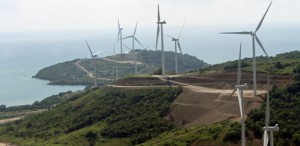APER seeks to help ‘stabilize, reduce’ Puerto Rico energy costs

Faced with the constant demand by consumers wanting relief in soaring energy costs and the government’s efforts to try to meet those expectations, the Association of Renewable Energy Producers went public Monday with a mission to help stabilize and reduce the price of energy in Puerto Rico.
During a news conference at a hotel in the Condado area of San Juan, Julián Herencia, executive director of the organization known as APER for its initials in Spanish, explained that the new group has several key goals.
“We want to contribute with the task of stabilizing and reducing energy costs, and serve as an educator for all sectors in Puerto Rico on the impact and contribution that renewable energy has in an objective, honest and accurate manner,” he said.
APER groups renewable energy producers, equipment and service providers as well as renewable energy consultants. The group also seeks to educate the public about the process of establishing renewable energy projects, generation and use of natural resources, partly to offset increasing costs.
“We’re coming together as partners and colleagues to join existing groups that promote renewable energy in Puerto Rico, those who have great concerns and doubts about the detrimental effect that it can have, the executive and legislative branches addressing this issue, and the Puerto Rico Electric Power Authority, the agency responsible of providing energy to the island, and its group of experts.”
The issue of turning to renewable energy to address Puerto Rico’s heavy dependency on fossil fuels, which affects costs to end users, whether residential or commercial, is not a matter of choice for PREPA. In 2010, Law 82 ordered the agency to open its grid up to renewable energy sources, looking to increase dependency the sun and the wind for power.
The law states that between 2015 and 2019, 12 percent of PREPA’s energy production must come from natural resources. By 2035, that number must be at 20 percent. If PREPA were to fall short on the laws requirements, it faces hefty fines at the local and federal levels.
At present, Puerto Rico’s renewable energy production reaches a meager 2 percent, while dozens of proposed projects await certifications to get going, APER representatives said.
“That’s precisely one of the reasons that motivated us to organizer APER. We aim to contribute to the discussion about what the most appropriate methods and practices are for Puerto Rico, as well as to the evaluation and recommendation of cutting-edge technology for renewable energy generation,” said Herencia.
A total of 56 renewable energy projects are on the table, representing a $5.3 billion investment and the potential to create more than 18,000 jobs.
Providing solutions to existing challenges
Herencia told members of the media that APER seeks to provide solutions to remaining challenges that producers are facing to get going, especially with regards to PREPA.

The massive windmills operating at the Punta Lima wind farm, one of the few companies that already have a power purchase and operating agreement with PREPA.
“We have technical and viability challenges that must be addressed, defined and implemented. That includes interconnection issues and stabilizing the network. There is an urgency to act now and not miss out on the window of opportunity to comply with laws, as well as local and federal benefits that make renewable energy projects possible,” Herencia said.
The group also seeks to clear up doubts related to the environmental impact of such solar and wind-powered projects, as well as their potential effects on human health.
“We want to address the concerns over irreversibly converting farmlands into renewable energy farms,” he said, noting that to meet the 2015 production goal, renewable energy project proponents would need some 5,300 acres of farmlands to develop.
APER also seeks to ensure that regulations and processes prescribed by federal and state agencies regarding these projects are met. That said, the group is slated to testify before the House Agriculture, Natural Resources, Energy and Environmental Affairs Committee on a measure proposing an investigation into the status of Law 82’s compliance.
APER is working with analyst firm Estudios Técnicos on a study to paint a complete picture of how renewable energy is being incorporated into the mix now and in the future.















